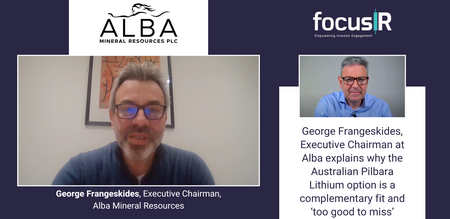The latest Investing Matters Podcast episode featuring Jeremy Skillington, CEO of Poolbeg Pharma has just been released. Listen here.
- Home
- Share Prices
- AQSE Share Prices
- Euronext
- Stock Screeners
- Share Chat
- FX
- News & RNS
- Events
- Media
- Trading Brokers
- Finance Tools
- Members
 View Video
View Video View Video
View VideoLatest Share Chat
- RKH. I don't think it was constru...
- IDS. @ Oli G. The Ice...
- BOOM. Zak the contradictions and h...
- DEC. Ahhh - It's cute to see the ...
- IDS. WolvesDipper - ‘Aimed at t...
- BT.A. He could have done more Flec...
- UKW. Hi Chatroom, No,...
- CHLL. I seriously doubt anyone wil...
- MATD. “You are misleading people...
- XLM. I saw that post earlier and ...
- Profiles
- fardistanthills
Member Info for Fardistanthills
Posts (Last 30 Days)
Posts (All Time)
Last Post
Member Since
Share Chat Post Distribution over the last 30 days
Well said indeed - and if all is as it seems, whenever data is released the impact of its release on shareholders will be as nothing compared to the impact on all those yet to be diagnosed with cancer.
Assuming data is being disclosed to / discussed with the FDA, there will come a tipping point as it were, when the sheer volume of what is being disclosed becomes market sensitive, forcing AVCT to fully update the market. One will drive t'other.
Spot on Wiggly - and that's coming from someone that says they are not boosters!
I guess the writing was on the wall that trials in the US would be the priority when the article appeared in the FT. Fantastic RNS.
FDH
Toukankahmoon This will sound very arrogant and condescending on my part for which I apologise but to be blunt you are not one of the posters on here that I set much store by. And if it’s mutual I have no problem with that either.
Good post PL75. The thing to say about AVCT's LFT endeavour was that it was done in a hell of a scrabble, with no reliable external support - think Porton Down - and without being able to get any competent external validation - think unscrupulous Spanish medical chancers. As to the way us SHs were treated at the time? Well AS no doubt saw it as gamble but one worth taking on as an opportunity to demonstrate the potential of affimers. And to his credit from what I could tell at the time, corners were not cut in the internal development work.
The contrast as you say with AVA6k is like day is to night. Complete regulatory and medical trial oversight, UK & USA external supervision of patient safety and outcomes, timelines dictated by therapeutic safety and efficacy rather than company targets, data gathered to be peer reviewed and any ultimate pharma approvals in accord with longstanding medical practice.
To heap doubt on AVCT's drug development capabilities by looking back on its Covid LFT work indicates inadequate investment analysis or mischief making - or both
Just doing one of my occasional skims through recent posts and found the below from C2H5O, which I found rather amusing. Answering these sorts of questions is, err, actually what AVCT is working away on - accumulating data, but not releasing it until they are fully happy with its quality. At some point – perhaps not quite shortly – an RNS will appear giving us all the answers - good, better, unexpected, whatever? But what I am absolutely certain about is that looking for answers on LSE ain’t going to work. Anyone with any sort of scientific nouse wouldn’t be here expecting to see all the relevant data, informed ‘guesses’ maybe... 'the market' may want to see it but I'm afraid 'the market' will have to wait for the release of probably a succession of RNS statements.
C2H5O... I’m trying to find the actual data here, particularly what the free plasma level of ...is / uptake into non cancer cells if by a direct cell surface reaction. With regard to the analysis of cancer cells taking up doxorubicin, again exactly what we want to hear. But I’d like to know the exact amount taken up, and what the equivalent dose of ‘normal’ doxorubicin treatment would have been required to achieve this? And hence, what would the side effect profile of ‘normal’ doxorubicin been at that level. What I really want to see is intracellular levels of doxorubicin being achieved that are equal to, or greater than, the present MTD of ‘normal’ doxorubicin. I know that’s what the 1b trial will hopefully achieve... I simply want to see all the relevant data. I’m guessing the rest of the market does as well.
Them were the days indeed! In them thar pre 'X' days I used a regional broker in a small seaside town. Calling in on him on a cold winters day he would be sat in his poky office, coal fire blazing, and when asked for an indicative price he would take a look across at his teletext screen.
(Nicepair 9.47 today - spot on re state of the market over the last 2 years)
Thanks, interesting read. RE Takeda...
Only 9 of 16 companies achieved positive R&D productivity based on the commercial returns from their new drugs versus R&D costs. The other 7 companies had negative R&D productivity but used mergers and acquisitions to compensate financially. Takeda was the only company with sustained negative productivity.
And a bit off topic but this rings so true!
Imagine that you are the head of R&D, and a consulting firm comes up with a recommendation to shut down the internal preclinical R&D and to focus only on in-licensing and clinical trials. Would you hire that consulting firm again? Consulting firms are likely to present solutions that satisfy the stakeholders - a consensus scenario that the requesting parties want to hear and pay for.
Thx cj62
Its one of the possibilities that crossed my mind too DTW.
Another thought being that having better realised / firmed up on the scale of the opportunity they have on their hands - based on all their very recent trial data - they have made a sudden switch in direction or a sudden making up of minds - towards rapid in house development of an initial therapy - in order to showcase the others which will follow. Showcasing one would be the best way of creating 'an auction' for all the other possibilities. It does smack of being a bit sudden?
I'm not looking in here often enough!
The link to the post advert no longer seems to work - it seems to have disappeared from AVCT's web pages?
Agree its an encouraging development though.
The possibility of that sort of scenario has me intrigued too Icecool.
My thanks too
Got my interest too. Does a weakened protective stroma also mean the 'bodies natural defences' - whatever they are - can more readily get into and degrade the tumour area itself? Presumably the whole point of the stroma protection is to keep out the 'bodies natural defences' - whatever they are.
Wiggly - every time I re- read through it I realise every bit of it is amazing!
Brilliant in every possible way - amazing news - fantastic RNS- all credit to everyone at Avacta for 'just getting on with the work' - what an understatment that was!
Absolutely fantastic for cancer patients. Thanks for pointing out perhaps the most telling bit Wiggly - on my first excited reading, being one of the headlines I missed it. So to repeat...
Several patients remain on trial in different dose cohorts and continue to receive AVA6000 as their disease has not progressed.
This really does raise all sorts of questions and posibilities
ES - interesting indeed. All part of Operation Roche?
... brought in to advise on the rights and licences to the Pre/Cision platform?
Clinigen ... acquires the rights to medicines from drug developers, produces them via contract manufacturers, and distributes them around the world... offering services... such as selling their drugs around the world and running clinical trials for them.
'take it' - and as others have said, good appointment - the company is maturing nicely.
